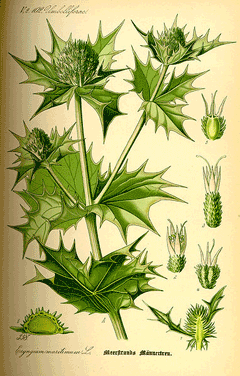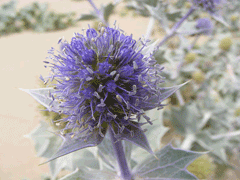 |
|
http://commons.wikimedia.org/wiki/File:Illustration_Eryngium_maritimum0.jpg |
 |
| http://commons.wikimedia.org/wiki/User:TeunSpaans |
Translate this page:
Summary
Physical Characteristics

 Eryngium maritimum is an evergreen Perennial growing to 0.5 m (1ft 8in) by 0.4 m (1ft 4in).
Eryngium maritimum is an evergreen Perennial growing to 0.5 m (1ft 8in) by 0.4 m (1ft 4in).
See above for USDA hardiness. It is hardy to UK zone 5. It is in leaf all year, in flower from July to October. The species is hermaphrodite (has both male and female organs) and is pollinated by Bees, flies, beetles. The plant is self-fertile.
It is noted for attracting wildlife.
Suitable for: light (sandy) and medium (loamy) soils, prefers well-drained soil and can grow in nutritionally poor soil. Suitable pH: mildly acid, neutral and basic (mildly alkaline) soils and can grow in very alkaline and saline soils.
It cannot grow in the shade. It prefers dry or moist soil and can tolerate drought. The plant can tolerate maritime exposure.
UK Hardiness Map
US Hardiness Map
Synonyms
Plant Habitats
Cultivated Beds;
Edible Uses
Edible Parts: Leaves Root Shoots
Edible Uses:
Young shoots - cooked[46, 61, 66]. They are normally blanched by excluding light from the growing plant, and are then used as an asparagus substitute[2, 115, 183]. They are said to be palatable and nourishing[4]. Root - cooked[2]. Used as a vegetable or candied and used as a sweetmeat[5, 66, 115]. Palatable and nutritious[4], it is slightly sweet and smells of carrots[13]. The boiled or roasted roots are said to resemble parsnips or chestnuts in flavour[2, 183].
References More on Edible Uses
Medicinal Uses
Plants For A Future can not take any responsibility for any adverse effects from the use of plants. Always seek advice from a professional before using a plant medicinally.
Aphrodisiac Aromatic Diaphoretic Diuretic Expectorant Stimulant Tonic
Sea holly roots were collected on a large scale in the 17th and 18th centuries in England and were candied then used as restorative, quasi-aphrodisiac lozenges[238]. The plant is still used in modern herbalism where it is valued especially for its diuretic action[254]. The root is to be aphrodisiac, aromatic, diaphoretic, diuretic, expectorant, stimulant and tonic[4, 165, 200]. The root promotes free expectoration and is very useful in the treatment of debility attendant on coughs of chronic standing in the advanced stages of pulmonary consumption[4]. It is used in the treatment of cystitis, urethritis, as a means to alleviate kidney stones (it is unlikely that it dissolves the stones, but it probably helps to retard their formation), and to treat enlargement or inflammation of the prostate gland[254]. Drunk freely, it is used to treat diseases of the liver and kidneys[4, 238]. Used externally as a poultice, the dried powdered root aids tissue regeneration[268]. The root should be harvested in the autumn from plants that are at least 2 years old[4].
References More on Medicinal Uses
The Bookshop: Edible Plant Books
Our Latest books on Perennial Plants For Food Forests and Permaculture Gardens in paperback or digital formats.

Edible Tropical Plants
Food Forest Plants for Hotter Conditions: 250+ Plants For Tropical Food Forests & Permaculture Gardens.
More

Edible Temperate Plants
Plants for Your Food Forest: 500 Plants for Temperate Food Forests & Permaculture Gardens.
More

More Books
PFAF have eight books available in paperback and digital formats. Browse the shop for more information.
Shop Now
Other Uses
References More on Other Uses
Cultivation details
Requires a deep well-drained soil and a sunny position[1]. Prefers a light sandy saline soil but tolerates most soil types including lime and poor gravels[200, 268]. Plants are best grown in a hot dry position[187, 233]. Established plants are drought tolerant[190]. Plants are hardy to about -15°c[187]. Sea holly has very long roots that penetrate deeply in the soil and are often several feet long[4]. These roots are sweetly scented[245]. The plant should be placed in its final position whilst small since it resents root disturbance[200]. Although a sea-shore plant, it is amenable to garden cultivation[4]. A good bee plant[108]. For polyculture design as well as the above-ground architecture (form - tree, shrub etc. and size shown above) information on the habit and root pattern is also useful and given here if available. The plant growth habit is a clumper with limited spread [1-2]. The root pattern is a tap root similar to a carrot going directly down [1-2].
References Carbon Farming Information and Carbon Sequestration Information
Temperature Converter
Type a value in the Celsius field to convert the value to Fahrenheit:
Fahrenheit:
The PFAF Bookshop
Plants For A Future have a number of books available in paperback and digital form. Book titles include Edible Plants, Edible Perennials, Edible Trees,Edible Shrubs, Woodland Gardening, and Temperate Food Forest Plants. Our new book is Food Forest Plants For Hotter Conditions (Tropical and Sub-Tropical).
Shop Now
Plant Propagation
Seed - best sown as soon as it is ripe in early autumn on the surface of a well-drained compost in a cold frame[200]. The seed can also be sown in spring. Germination can be very slow[4], although another report says that the seed usually germinates in 5 - 90 days at 20°c. When they are large enough to handle, prick the seedlings out into individual pots and grow them on in the greenhouse for their first winter. Plant them out into their permanent positions in late spring or early summer, after the last expected frosts. Division in early spring or autumn. Take care since the plant resents root disturbance[200]. Root cuttings in autumn or winter[200].
Other Names
If available other names are mentioned here
Native Range
TEMPERATE ASIA: Georgia, Israel, Lebanon, Syria (west), Turkey (north & west),Cyprus. EUROPE: Denmark, United Kingdom (U.K.), Ireland, Norway, Sweden, Belgium, Germany, Netherlands, Poland, Estonia, Lithuania, Latvia, Moldova, Ukraine (incl. Krym), Albania, Bulgaria, Greece (incl. Crete), Croatia, Italy (incl. Sardinia, Sicily), Montenegro, Romania, Slovenia, Spain (incl. Baleares), France (incl. Corsica), Portugal, AFRICA: Algeria (north), Egypt (north), Libya (north), Morocco, Tunisia.
Weed Potential
Right plant wrong place. We are currently updating this section.
Please note that a plant may be invasive in one area but may not in your area so it's worth checking.
Conservation Status
IUCN Red List of Threatened Plants Status :

Growth: S = slow M = medium F = fast. Soil: L = light (sandy) M = medium H = heavy (clay). pH: A = acid N = neutral B = basic (alkaline). Shade: F = full shade S = semi-shade N = no shade. Moisture: D = dry M = Moist We = wet Wa = water.
Now available:
Food Forest Plants for Mediterranean Conditions
350+ Perennial Plants For Mediterranean and Drier Food Forests and Permaculture Gardens.
[Paperback and eBook]
This is the third in Plants For A Future's series of plant guides for food forests tailored to
specific climate zones. Following volumes on temperate and tropical ecosystems, this book focuses
on species suited to Mediterranean conditions—regions with hot, dry summers and cool, wet winters,
often facing the added challenge of climate change.
Read More
Expert comment
Author
L.
Botanical References
17200
Links / References
For a list of references used on this page please go here
Readers comment
| Add a comment |
|
If you have important information about this plant that may help other users please add a comment or link below. Only comments or links that are felt to be directly relevant to a plant will be included. If you think a comment/link or information contained on this page is inaccurate or misleading we would welcome your feedback at [email protected]. If you have questions about a plant please use the Forum on this website as we do not have the resources to answer questions ourselves.
* Please note: the comments by website users are not necessarily those held by PFAF and may give misleading or inaccurate information.
To leave a comment please Register or login here All comments need to be approved so will not appear immediately.
|
Subject : Eryngium maritimum
|
|
|
|